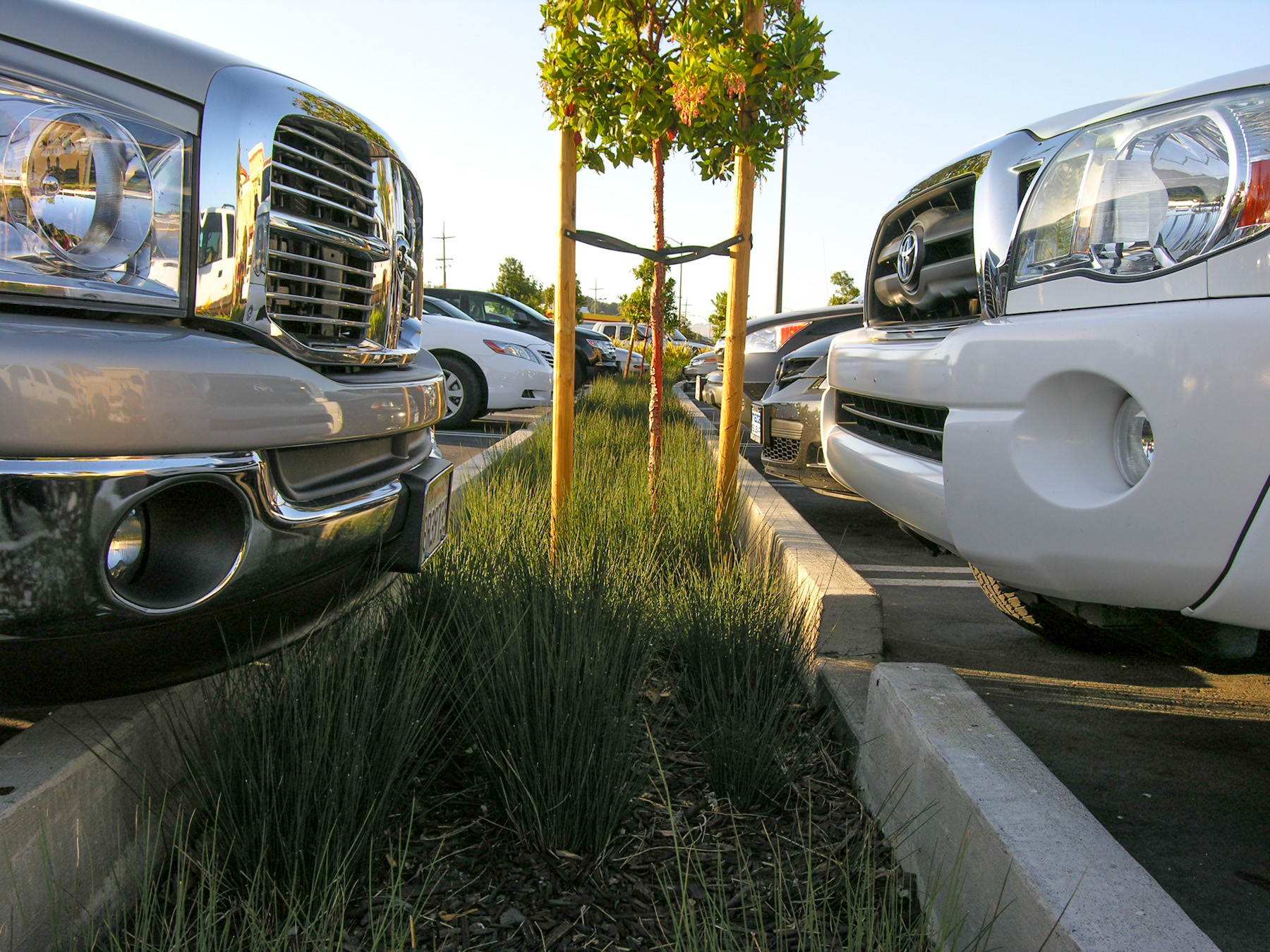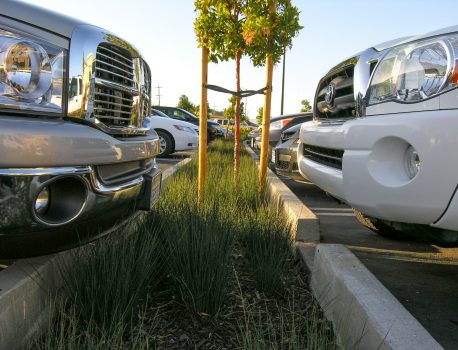Post Construction Requirements and Low Impact Development Resources
This page provides information and resources intended for development project applicants, architects, engineers, contractors, planners, landscape architects, municipal staff and the general public.
- Development projects may be required to control pollutants in runoff from newly created or replaced impervious surfaces. Explore the Post Construction Requirements in Marin panel below for more information.
- In Marin, some development projects must follow the BASMAA Post Construction Manual and must submit a Stormwater Control Plan. Explore the resources and templates in the How to Comply: Additional Tools and Guidance panel below.
- Find out how to protect our creeks, bays and the ocean by exploring the Low Impact Development (LID) Resources panel below.
- Post-Construction Stormwater Workshop presented by Dan Cloak. These training materials review how to incorporate Low Impact Development (LID) into north bay projects.
- Slow the Flow, Keep Rain Onsite!
Certain development projects in Marin must follow the applicable guidance manual listed below:
- BASMAA Post Construction Manual: The Manual was created to assist development project applicants to prepare submittals that demonstrate compliance with the National Pollutant Discharge Elimination System (NPDES) 2013 Phase II Permit E.12 Requirements and/or local requirements. Projects subject to the requirements must follow the Manual and submit the appropriate Stormwater Control Plan based on project type. Regulated Projects, as defined in the Manual, are required to incorporate bioretention facilities into the drainage design. The BASMAA Post Construction Manual includes Stormwater Control Plan Templates. Editable versions of the templates and additional tools and guidance follow:
- Small and Single Family Home Project Stormwater Control Plan Template (Appendix C)
- Regulated Projects can use:
- Regulated Project Stormwater Control Plan Template (Appendix D) – Contact MCSTOPPP for editable Word Document format
- Operation and Maintenance Plan Template 2019 – Contact MCSTOPPP for editable Word Document format
- Operation and Maintenance Agreement Template for Private Projects – Contact MCSTOPPP for editable Word Document format
- E12 Sizing Calculator (fillable) for regulated projects and Instructions
- Bioretention Facility Plant List
- Examples for Commercial Projects
- Example for Residential subdivisions
- Bioretention Soil Specification Guidance
- BASMAA Regional Biotreatment Soil Specification – April 2016
- Non-LID treatment facilities
- Page 3-5 in the BASMAA Post Construction Manual lists circumstances for non-LID treatment facilities
- Technical Criteria for Non-LID Treatment Facilities provides conditions to achieve permit requirements.
- Hydromodification Management Requirements
- Projects that add/replace 1 acre of impervious area with a net increase in impervious must meet the Phase II Permit hydromodification management requirements described in permit section E.12.f. Project proponents may follow the BASMAA Post Construction Manual to comply with section E.12.f.
- For more information, read Evaluating Hydromodification Performance of Bioretention
Check with the local permitting agency for more information on specific post construction stormwater treatment and control requirements.
Additional Guidance for Development Professionals
- Bioretention Soil Media Specifications
- Rain Gardens – Fact sheet on rain gardens and stormwater control for small projects. Produced by Bay Area Management Agencies Association (BASMAA) Includes: checklist for feasibility, general recommendations for size, guidance on how to plan and install a rain garden, selection of appropriate plants, design checklist, and maintenance considerations.
- Start at the Source (1999) – Design guidance Manual for Stormwater Quality Protection
- Using Site Design Techniques to Meet Development Standards for Stormwater Quality (May 2003) Companion document to Start at the Source a design guidance Manual for Stormwater Quality Protection
- Creating Pervious Surfaces for New Development and Redevelopment – A Guide for Surface Water Pollution Control and Best Management Practices
Marin’s cities, towns and unincorporated areas must require designated development projects to comply with Provision E.12 of the State Water Resources Control Board (State Water Board) under the Phase II National Pollutant Discharge Elimination System (NPDES) Municipal Stormwater Permit (Phase II Permit). Provision E.12 requires site designs for new developments and redevelopments that are defined as Regulated Projects (or where required by the local agency) to minimize the area of new roofs and paving. Where feasible, pervious surfaces should be used instead of paving so that runoff can infiltrate to the underlying soil. Remaining runoff from impervious areas must be captured and used or treated using bioretention. Regulated Projects must also incorporate pollutant source control best management practices into the site design. Certain Small Projects and Single Family Home Projects (not part of a larger plan of development) must implement at least one site design measure and must show the decrease in runoff from the site.
Post Construction Alert – Fact Sheet on the E.12 requirements that are also described in the BASMAA Post Construction Manual.
Projects subject to the E.12 Requirements
The table below outlines the various categories of projects that are subject to E.12 Post Construction requirements.
| Type of Project | Project Requirements | Your Submittal |
|---|---|---|
| Single Family Homes: Projects that create or replace 2,500 square feet or more of impervious surface
Small Projects: Projects that create or replace between 2,500 and 5,000 square feet of impervious surface |
Site Design measures:
1. Limit clearing, grading and soil compaction 2.Minimize impervious surfaces 3. Reduce runoff, for example by dispensing runoff to landscaping or using pervious pavements 4. Conserve natural areas of the site as much as possible consistent with local General Plan 5. Comply with stream setback ordinances/requirements 6. Protect slopes and channels against erosion |
Follow the instructions in the template: Small and Single Family Home Project Stormwater Control Plan (Appendix C) |
| Required Projects: Projects other than single family homes that create or replace 5,000 square feet or more of impervious surface | Site Design measures addition to those for small projects:
1. Route runoff to bioretention or other facilities sized and designed according to criteria in Chapter 4 BASMAA Post Construction Manual 2. Identify potential sources of pollutants and implement corresponding source control measures in Appendix A BASMAA Post Construction Manual 3. Provide ongoing maintenance of bioretention facilities |
Follow the instructions in the template: Regulated Project Stormwater Control Plan (Appendix D) |
| Roads and Linear Utility Projects: Projects that create 5,000 square feet or more of newly constructed contiguous impervious surface | Requirements vary | Complete the “Model Sign-Off Form” (Appendix G). Contact your local stormwater coordinator regarding compliance options |
For requirements at a glance for projects in San Anselmo see specific E.12 applicability table for that jurisdiction.
Preparing for requirements during construction
All post construction stormwater management requirements are separate from, and in addition to, requirements for erosion and sediment control and other pollution prevention measures during construction. Construction projects over an acre are subject to the State of California’s General Construction Permit.
If you’re planning to develop or redevelop a property, consider redesigning your drainage to reduce water quality impacts. Rain runoff carries pollutants to creeks and other water bodies. When rain flows over hard surfaces the speed and volume of water can cause creek erosion downstream. For ideas on how to use Low Impact Development design to protect fish and other wildlife in Marin’s creeks, explore the resources below and consider implementing the following practices:
- Disconnect downspouts to let water run off your roof onto a splash block and into landscaped areas.
- Install a rain barrel.
- Slow down your roof runoff by connecting rain chains to your roof gutters.
- Use mulch on plant beds to slow the flow in areas where water can seep in.
- Consider installing a rain garden.
LID and Stormwater-Friendly Development Resources
- LID – A Sensible Approach to Land Development and Stormwater Management – from the California Water and Land Use Partnership
- Blue-Green Building – Water Friendly Development in the East Bay – Sustainable water friendly development.
- Using Bioretention on Residential Lots – How to incorporate bioretention facilities into residential lots including how to calculate sizing.
- Slow It. Spread It. Sink It – Find more information on our Rainwater Capture and Management page
- BASMAA Rain Gardens Fact Sheet – A 4-page technical guide on how to build a rain garden.


